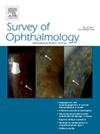Inherited retinal disease-associated uveitis
IF 5.9
2区 医学
Q1 OPHTHALMOLOGY
引用次数: 0
Abstract
Inherited retinal diseases (IRDs) are genetic disorders characterized by progressive photoreceptor function loss, often leading to significant visual impairment. Uveitis has been increasingly recognized in the clinical course of some IRDs. Despite advances in understanding the genetic causes and pathophysiology of IRDs, gaps remain in understanding the roles of inflammation and autoimmunity in IRD and IRD-associated uveitis. This review discusses IRD-associated uveitis, including anterior, intermediate, posterior, and panuveitis, as well as complications such as cystoid macular edema and retinal vasculitis. In patients with IRD-associated uveitis, mutations affecting protein function in cilia or photoreceptor outer segments suggest a universal autoimmune mechanism triggered by the immunogenicity of shedding photoreceptor discs. Notably, in patients where uveitis is the initial sign, CRB1 mutations are often implicated, likely due to the compromised blood-retina barrier function or alterations in the external limiting membrane. Other mechanisms leading to uveitis preceding IRD diagnosis include ALPK1 mutations, which activate the proinflammatory NF-κB pathway, CAPN5 mutations, which lead to dysfunction of the innate and adaptive immune systems, and VCAN1 mutations, which elicit immunogenicity due to irregularities in vitreous modeling. Understanding these mechanisms could enhance the development of innovative treatments that target personalized inflammation pathways in IRDs.
遗传性视网膜疾病相关的葡萄膜炎。
遗传性视网膜疾病(IRDs)是一种以进行性光感受器功能丧失为特征的遗传性疾病,通常导致严重的视力障碍。葡萄膜炎在一些ird的临床过程中得到越来越多的认识。尽管在了解IRD的遗传原因和病理生理方面取得了进展,但在了解炎症和自身免疫在IRD和IRD相关葡萄膜炎中的作用方面仍然存在空白。本文综述了ird相关的葡萄膜炎,包括前、中、后、全葡萄膜炎,以及并发症,如囊样黄斑水肿和视网膜血管炎。在ird相关性葡萄膜炎患者中,影响纤毛或光感受器外段蛋白功能的突变提示由脱落的光感受器盘的免疫原性触发的普遍自身免疫机制。值得注意的是,在以葡萄膜炎为初始征象的患者中,CRB1突变通常涉及,可能是由于血视网膜屏障功能受损或外限制膜。在IRD诊断之前导致葡萄膜炎的其他机制包括ALPK1突变(激活促炎NF-κB途径)、CAPN5突变(导致先天和适应性免疫系统功能障碍)和VCAN1突变(由于玻璃体模型的不规则性而引起免疫原性)。了解这些机制可以促进针对ird中个性化炎症途径的创新治疗的发展。
本文章由计算机程序翻译,如有差异,请以英文原文为准。
求助全文
约1分钟内获得全文
求助全文
来源期刊

Survey of ophthalmology
医学-眼科学
CiteScore
10.30
自引率
2.00%
发文量
138
审稿时长
14.8 weeks
期刊介绍:
Survey of Ophthalmology is a clinically oriented review journal designed to keep ophthalmologists up to date. Comprehensive major review articles, written by experts and stringently refereed, integrate the literature on subjects selected for their clinical importance. Survey also includes feature articles, section reviews, book reviews, and abstracts.
 求助内容:
求助内容: 应助结果提醒方式:
应助结果提醒方式:


